Luminosity (bolometric) 0.000525±0.000036 L☉ Radial velocity (Rv) ~12×10−3 km/s | Absolute magnitude (MV) 18.4±0.1 Luminosity (visual, LV) 0.00000373 L☉ V−R color index 2.33 | |
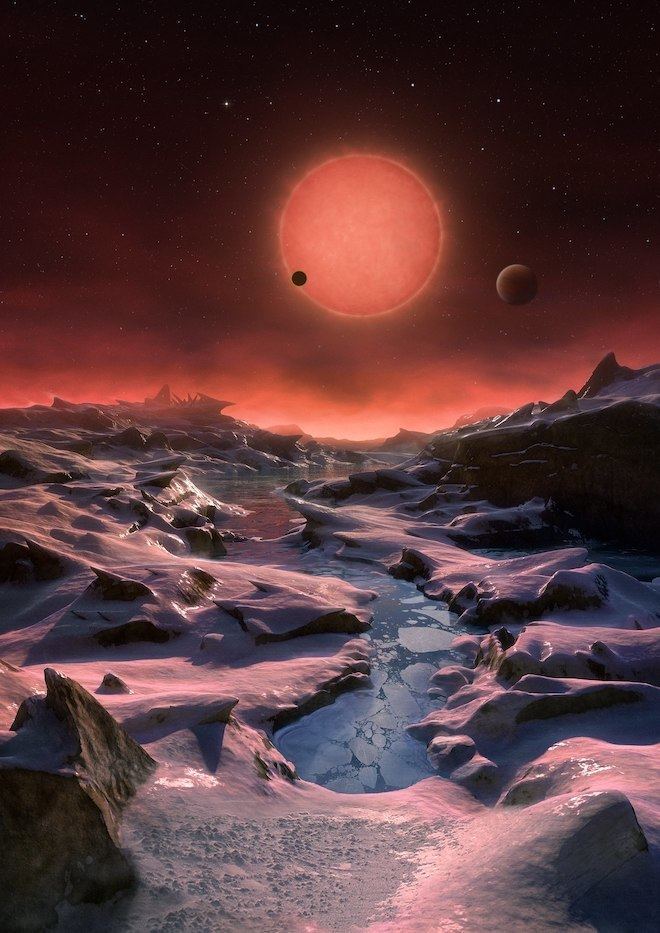 | ||
Similar Kepler‑442b, Proxima Centauri, HD 85512 b, Gliese 163 c, Kepler‑186f | ||
Nasa trappist 1 a treasure trove of planets found
TRAPPIST-1, also designated as 2MASS J23062928-0502285, is an ultra-cool dwarf star that is slightly larger but much more massive than the planet Jupiter, located 39.5 ly (12.1 pc) from the Sun in the constellation Aquarius. The dwarf star has been shown to host seven temperate terrestrial planets, a larger number than detected in any other planetary system.
Contents
- Nasa trappist 1 a treasure trove of planets found
- What s the significance of trappist 1
- Discovery and nomenclature
- Stellar characteristics
- Planetary system
- Orbital near resonance
- Formation of the planetary system
- Tidal locking
- Tidal heating
- Possible effects of strong X ray and extreme UV irradiation of the system
- Spectroscopy of planetary atmospheres
- Probability of interplanetary panspermia
- Radio signal search
- References
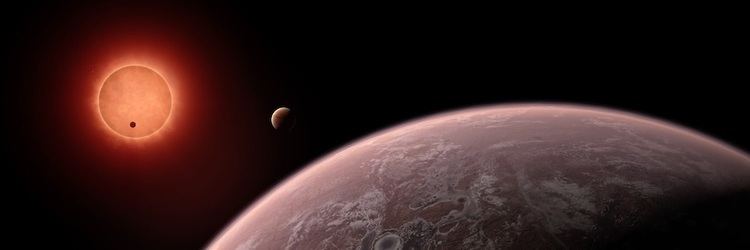
Astronomers first discovered three Earth-sized planets orbiting the dwarf star in 2015. A team led by Michaël Gillon at the University of Liège in Belgium detected the planets using transit photometry with the Transiting Planets and Planetesimals Small Telescope (TRAPPIST) at the La Silla Observatory in Chile. On 22 February 2017, astronomers announced four additional exoplanets around TRAPPIST-1. This work used the NASA Spitzer Space Telescope and the Very Large Telescope at Paranal, among others, and brought the total number of planets to seven, of which three are considered to be within its habitable zone. The others could also be habitable as they may possess liquid water somewhere on their surface.
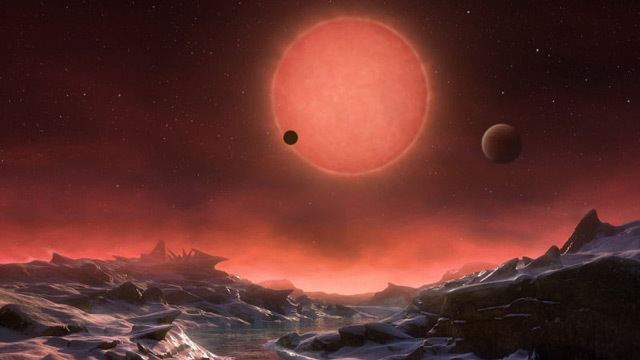
What s the significance of trappist 1
Discovery and nomenclature

The star at the center of the system was discovered in 1999 during the Two Micron All-Sky Survey (2MASS). It was entered in the subsequent catalog with the designation "2MASS J23062928-0502285". The numbers refer to the right ascension and declination of the star's position in the sky and the "J" refers to the Julian Epoch.
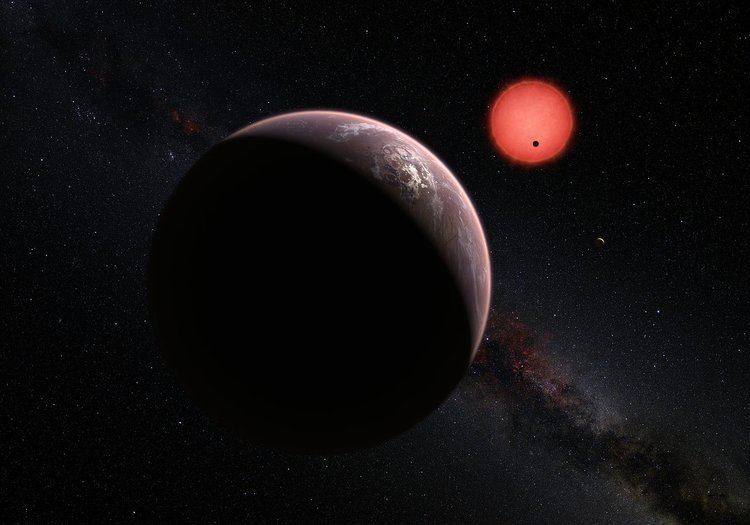
The system was later studied by a team at the University of Liège, who made their initial observations using the TRAPPIST–South telescope from September to December 2015 and published their findings in the May 2016 issue of the journal Nature. The backronym TRAPPIST reflects the telescope's nationality by alluding to Belgium's famous Trappist beer named from the Roman Catholic religious order, which the astronomers also used to toast their discovery. Since the star hosted the first exoplanets discovered by this telescope, the discoverers accordingly designated it as "TRAPPIST-1".
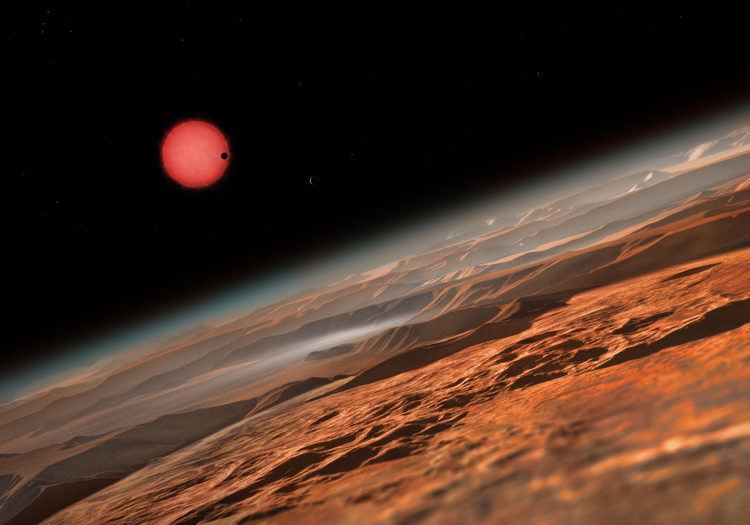
The planets are designated in the order of their discovery, beginning with b for the first planet discovered, c for the second and so on. Three planets around TRAPPIST-1 were first discovered and designated b, c and d in order of increasing orbital periods, and the second batch of discoveries was similarly designated e to h.
Stellar characteristics
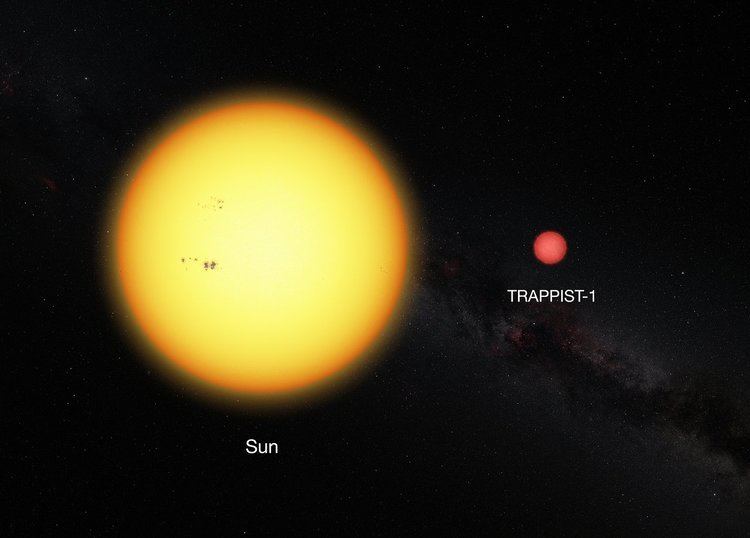
TRAPPIST-1 is an ultra-cool dwarf star of spectral class M8.0±0.5 that is approximately 8% the mass of and 11% the radius of the Sun. Although it is slightly larger than Jupiter, it is about 84 times more massive. High-resolution optical spectroscopy failed to reveal the presence of lithium, suggesting it is a very low-mass main-sequence star, which is fusing hydrogen and has depleted its lithium, i.e., a red dwarf rather than a very young brown dwarf. It has a temperature of 2,550 K (2,280 °C; 4,130 °F), and its age has been estimated to be in the range of 3 to 8 Gyr. In comparison, the Sun has a temperature of 5,778 K (5,505 °C; 9,941 °F) and an age of about 4.6 Gyr. Observations with the Kepler K2 extension for a total of 79 days revealed starspots and infrequent weak optical flares at a rate of 0.38 per day (30-fold less frequent than for active M6–M9 dwarfs); a single strong flare appeared near the end of the observation period. The star has a rotational period of 3.3 days.
High-resolution speckle images of TRAPPIST-1 were obtained and revealed that the M8 star has no companions with a luminosity equal to or brighter than a brown dwarf. This determination that the host star is single confirms that the measured transit depths for the orbiting planets provide a true value for their radii, thus proving that the planets are indeed Earth-sized.
Owing to its low luminosity, the star has the ability to live for up to 12 trillion years. It is metal-rich, with a metallicity ([Fe/H]) of 0.04, or 109% the solar amount. Its luminosity is 0.05% of that of the Sun (L☉), most of which is emitted in the infrared spectrum, and with an apparent magnitude of 18.80 it is not visible to the naked eye.
Planetary system
In February 2017, astronomers announced that the planetary system of this star is composed of seven temperate terrestrial planets, of which five (b, c, e, f and g) are similar in size to Earth, and two (d and h) are intermediate in size between Mars and Earth. Three of the planets (e, f and g) orbit within the habitable zone.
The system is very flat and compact. All seven of TRAPPIST-1's planets orbit much closer than Mercury orbits the Sun. Except for TRAPPIST-1b, they orbit farther than the Galilean satellites do around Jupiter, but closer than most of the other moons of Jupiter. The distance between the orbits of TRAPPIST-1b and TRAPPIST-1c is only 1.6 times the distance between the Earth and the Moon. The planets should appear prominently in each other's skies, in some cases appearing several times larger than the Moon appears from Earth. A year on the closest planet passes in only 1.5 Earth days, while the seventh planet's year passes in only 18.8 days.
The planets pass so close to one another that gravitational interactions are significant, and their orbital periods are nearly resonant. In the time the innermost planet completes eight orbits, the second, third, and fourth planets complete five, three, and two. The gravitational tugging also results in transit-timing variations (TTVs), ranging from under a minute to over 30 minutes, which allowed the investigators to calculate the masses of all but the outermost planet. The total mass of the six inner planets is approximately 0.02% the mass of TRAPPIST-1, a fraction similar to that for the Galilean satellites to Jupiter, and an observation suggestive of a similar formation history. The densities of the planets range from ~0.60 to ~1.17 times that of Earth (ρ⊕, 5.51 g/cm3), indicating predominantly rocky compositions. The uncertainties are too large to indicate whether a substantial component of volatiles is also included, except in the case of f, where the value (0.60±0.17 ρ⊕) "favors" the presence of a layer of ice and/or an extended atmosphere. Speckle imaging excludes all possible stellar and brown dwarf companions.
Orbital near-resonance
The orbital motions of the TRAPPIST-1 planets form a complex chain with three-body Laplace-type resonances linking every member. The relative orbital periods (proceeding outward) approximate whole integer ratios of 24/24, 24/15, 24/9, 24/6, 24/4, 24/3, and 24/2, respectively, or nearest-neighbor period ratios of about 8/5, 5/3, 3/2, 3/2, 4/3, and 3/2 (1.603, 1.672, 1.506, 1.509, 1.342, and 1.519). This represents the longest known chain of near-resonant exoplanets, and is thought to have resulted from interactions between the planets as they migrated inward within the residual protoplanetary disk after forming at greater initial distances.
Formation of the planetary system
According to Ormel et al., previous models of planetary formation do not easily explain the formation of the highly compact TRAPPIST-1 system. Formation in place would require an unusually dense disk and would not readily account for the orbital resonances. Formation outside the frost line does not explain the planets' terrestrial nature or Earth-like masses. The authors proposed a new scenario in which planet formation starts at the frost line where pebble-size particles trigger instabilities, then protoplanets quickly mature by pebble accretion. Planet growth stalls at Earth mass. The planets are transported by Type I migration to the inner disk, where they stall at the magnetospheric cavity and end up in mean motion resonances. Such inward migration increases the odds of substantial amounts of water being present on these worlds.
Tidal locking
All seven planets are likely to be tidally locked (one side of each planet permanently facing the star), making the development of life there "much more challenging". A less likely possibility is that some may be trapped in a higher-order spin–orbit resonance. Tidally locked planets would typically have very large temperature differences between their permanently lit day sides and their permanently dark night sides, which could produce very strong winds circling the planets. The best places for life may be close to the mild twilight regions between the two sides, called the terminator line.
Tidal heating
Tidal heating is predicted to be significant: all planets except f and h are expected to have a tidal heat flux greater than Earth’s total heat flux.
Possible effects of strong X-ray and extreme UV irradiation of the system
Bolmont et al. modeled the effects of predicted far ultraviolet (FUV) and extreme ultraviolet (EUV/XUV) irradiation of planets b and c by TRAPPIST-1. Their results suggest that the two planets may have lost as much as 15 Earth oceans of water (although the actual loss would probably be lower), depending on their initial water contents. Nonetheless, they may have retained enough water to remain habitable, and a planet orbiting further out was predicted to lose much less water.
However, a subsequent XMM-Newton X-ray study by Wheatley et al. found that the star emits X-rays at a level comparable to our own much larger Sun, and extreme ultraviolet radiation at a level 50-fold stronger than assumed by Bolmont et al. The authors predicted this would significantly alter the primary and perhaps secondary atmospheres of close-in Earth-sized planets spanning the habitable zone of the star. The publication noted that these levels "neglected the radiation physics and hydrodynamics of the planetary atmosphere" and could be a significant overestimate. Indeed, the XUV stripping of a very thick hydrogen and helium primary atmosphere might actually be required for habitability. The high levels of XUV would also be expected to make water retention on TRAPPIST-1d less likely than predicted by Bolmont et al., though even on highly irradiated planets it might remain in cold traps at the poles or on the night sides of tidally locked planets.
If a dense atmosphere like Earth with a protective ozone layer exists on planets in the habitable zone (HZ) of TRAPPIST-1, UV surface environments would be similar to present day Earth. However an anoxic atmosphere, would allow more UV to reach the surface, making surface environments hostile to even highly UV-tolerant terrestrial extremophiles. If future observations detect ozone on one of the TRAPPIST-1 planets, it would be a prime candidate to search for surface life.
Spectroscopy of planetary atmospheres
Because of the system's relative proximity, the small size of the primary and the orbital alignments that produce daily transits, the atmospheres of TRAPPIST-1's planets are favorable targets for transmission spectroscopy investigation.
The combined transmission spectrum of TRAPPIST-1b and c, obtained by the Hubble Space Telescope, rules out a cloud-free hydrogen-dominated atmosphere for each planet, so they are unlikely to harbor an extended gas envelope, unless it is cloudy out to high altitudes. Other atmospheric structures, from a cloud-free water-vapor atmosphere to a Venus-like atmosphere, remain consistent with the featureless spectrum.
Another study hinted at the presence of a hydrogen exospheres around the two inner planets with a exospheric disks extending up to 7 times the planets’ radii. Observations by future telescopes, such as the James Webb Space Telescope or European Extremely Large Telescope, will be able to assess the greenhouse gas content of the atmospheres, allowing better estimation of surface conditions. They may also be able to detect biosignatures like ozone or methane in the atmospheres of these planets, if life is present there.
Probability of interplanetary panspermia
Panspermia is potentially orders of magnitude more likely to occur in the TRAPPIST-1 system compared to the Earth-to-Mars case and the probability of abiogenesis is enhanced.
Radio signal search
In February 2017, Seth Shostak, senior astronomer for the SETI Institute, noted: "... the SETI Institute used its Allen Telescope Array [in 2016] to observe the environs of TRAPPIST-1, scanning through 10 billion radio channels in search of signals. No transmissions were detected, although new observations are in the offing ..."
